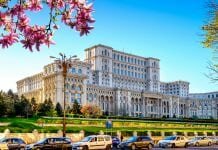
Mykola Gnatovskyy, president of the CPT, urged Macedonia to fix the structural problems causing poor material conditions in its prisons.
In October, the European Committee for the Prevention of Torture and Inhuman or Degrading Treatment or Punishment (CPT) made public a report on an ad hoc visit a delegation had made to the Former Yugoslav Republic of Macedonia from 6-9 December 2016. The main purpose of the visit was to inspect the conditions of detention and treatment in the country’s prisons, and to evaluate how much progress had been made in implementing the recommendations and suggested improvements made by the CPT on their last visit in 2014.
Unfortunately, the report revealed that the country’s prisons – including Idrizovo Prison, which holds around three-fifths of Macedonia’s prisoners and is one of the largest detention facilities in the region – continue to suffer from fundamental structural problems, resulting in a wealth of systemic problems and extremely poor conditions for prisoners. Despite regular periodic and ad hoc visits by the committee to Macedonia, very little progress has been made in improving the situation over the last ten years, forcing the CPT to pursue further action. PEN spoke to the president of the CPT, Mykola Gnatovskyy, to discuss the findings of the report, and the urgent steps needed to improve the state of prisons in Macedonia.
Structural problems
The president explained that during its visit the CPT identified fundamental problems in the structure and management of detention facilities: “We found that the authorities showed an inability to manage such complex institutions as prisons. There were problems with everything, including very poor material conditions, ill treatment of prisoners by prison staff as well as inter-prisoner violence, almost total abandonment of prisoners when it comes to their healthcare needs, and omnipresent corruption in the system. According to our committee, the situation can easily be described as amounting to inhuman or degrading treatment.”
From Gnatovskyy’s perspective, these problems relate to the mismanagement of prisons, which is in turn the result of the policy which governs Macedonia’s appointment of prison officials: “The prisons were not run by professional management because the system that currently exists in the country supposes that prison managers are political appointees, so it can be anyone. We met persons in charge who had very scarce managerial experience; in fact, for some the most complex institution that they had managed before was a petrol station.”
For this reason, Gnatovskyy continued, prison officials in many cases had less influence on the day to day management of the prison than some of the life sentence prisoners, or ‘lifers’: “The most influential people in Idrizovo were the lifers, who enjoyed excellent material conditions and were able to continue their business from inside the prison.” In fact, these prisoners had such control that to move a vulnerable prisoner to a separate protective wing away from the general population, the prison director had to spend four months negotiating with life-sentenced prisoners before they would allow him to do so. “Of course, this reflects a total lack of professionalism and lack of vision in how to deal with these complex issues.”
An ongoing concern
Perhaps the biggest cause for concern is the fact that the CPT has highlighted problems with the country’s prison system on many occasions since it started visiting Macedonia in 1998, and issued recommendations designed to improve both material conditions for prisoners and the structure and management of the system. However, based on the organisation’s recent visit, it is clear that many recommendations were not implemented, and the situation has continued to deteriorate. In 2009, Gnatovskyy’s predecessor, Mauro Palma, met with then Prime Minister of Macedonia Nikola Gruevski to discuss the urgent need for improvement highlighted by visits in 2006, 2007 and 2008. Unfortunately, the resulting actions by the government of the Former Yugoslav Republic of Macedonia did not effectively address the most practical concerns. Gnatovskyy explained: “The government then did try to implement certain things, and engaged in co-operation with the Council of Europe, but unfortunately, their priorities were not set well. They were producing a lot of papers, and a lot of rulebooks and guidelines, but those were very far from the reality on the ground.”
Because the situation in Macedonia has only become worse since then, and because the results of CPT’s report revealed such poor conditions and such mismanagement of the country’s prison system, the committee was forced to take decisive action. “The report made it inevitable,” Gnatovskyy said. “In March of this year, we opened a procedure that can lead to a public statement by committee, which is an extremely rare thing. We’ve made such statements only eight times in our 28 years.”
The procedure, however, has been set in motion on many more occasions. If a country makes sufficient progress, the statement may never be issued, but nevertheless, the opening of the procedure is CPT’s way of telling the government that enough is enough.
High level talks
It was in this context that Gnatovskyy met with current Macedonian Prime Minister Zoran Zaev on 14 October 2017, to discuss what actions the government would take to remedy the problem. Thankfully, the CPT president said that despite Macedonia’s previous failure to tackle the poor conditions in its prisons, the talks had left him optimistic that the country was ready to make progress: “I can only speak about my personal impression now, but it was quite positive. First of all, one of the first steps taken by Prime Minister Zaev was to visit Idrizovo Prison. After his visit he publicly said to the press that he was ashamed to be the prime minister of a country which has such a prison. He also made it clear that he has made a very firm commitment, not only to our committee but to the society in Macedonia, to change the situation. He showed a very good understanding of the issues and a very clear determination to deal with those issues.”
In addition to its engagement with the CPT, the Macedonian government has also been co-operating with the Council of Europe Development Bank, which could also help with making the significant improvements that are needed in the country. “It’s a matter of a professional approach on the part of the national authorities, so that they can utilise the resources that they have, and the resources they’re able to attract externally, in the most effective way,” Gnatovskyy summarised.
The committee will keep up its visits to the Former Yugoslav Republic of Macedonia to monitor the level of progress being made, but for now will likely give the country some time to implement the necessary changes. “There is clear commitment from the government and of course it will need time to yield some results,” the President concluded. “But also, our committee will need to be informed on a regular basis about the developments, so that we’re ready to react if necessary.”
For now, the CPT continues to follow the situation in the country very closely, but with a firm commitment from Macedonian authorities to work with the committee and to reform policies in order to improve both material conditions and structural concerns, it may be that the country is ready to turn things around.
Established in 1989, the European Committee for the Prevention of Torture and Inhuman or Degrading Treatment or Punishment (CPT) is an independent monitoring body of the Council of Europe. Through its membership of impartial experts – ranging from lawyers to medical doctors, to specialists in prison management – the committee monitors places of detention in all the 47-member states of the Council of Europe. The committee’s remit includes the ability to inspect any place of the deprivation of liberty which, according to CPT President Mykola Gnatovskyy, is a far broader mandate than simply the inspection of prisons: “By places of detention and deprivation of liberty, we mean any places where persons are kept according to a decision by a public authority against their will. Of course, this includes prisons, but it also includes police stations, immigration detention, and detention in psychiatric hospitals, social care homes, and many other similar places.”
In any such places, the detainees in question are potentially vulnerable to mistreatment, and to monitor this carefully in all of the Council of Europe’s member states, the CPT carries out both periodic and ad hoc visits, the scope of which is sometimes dictated by the findings upon previous visits. In 2017, the organisation carried out nine periodic visits and seven ad hoc visits, during which the visiting committee members are given far-reaching freedom and access to both the people and places they want to evaluate, Gnatovskyy said: “We have access to all persons. We can speak with the detained persons confidentially, without the presence of staff, and we have access to all the documentation and all premises.”
Following these visits, the CPT prepares a report which is shared confidentially with the government in question; on many occasions, these reports are published with the agreement of the government. However, the work does not end there, as the committee continues to engage in an ongoing and confidential dialogue with the authorities in these countries to improve the situation, where necessary. “We keep an ongoing dialogue with the authorities, so it is not just visiting the countries and then sending them a report, but it’s also talking to them about the implementation of our recommendations, coming back with ad hoc visits, coming back to speak with the government and hold high-level talks, and so forth. This is an unending process.”
European Committee for the Prevention of Torture and Inhuman or Degrading Treatment or Punishment
http://www.cpt.coe.int
This article will appear in Pan European Networks: Government 24, which will be published in January, 2018.



















